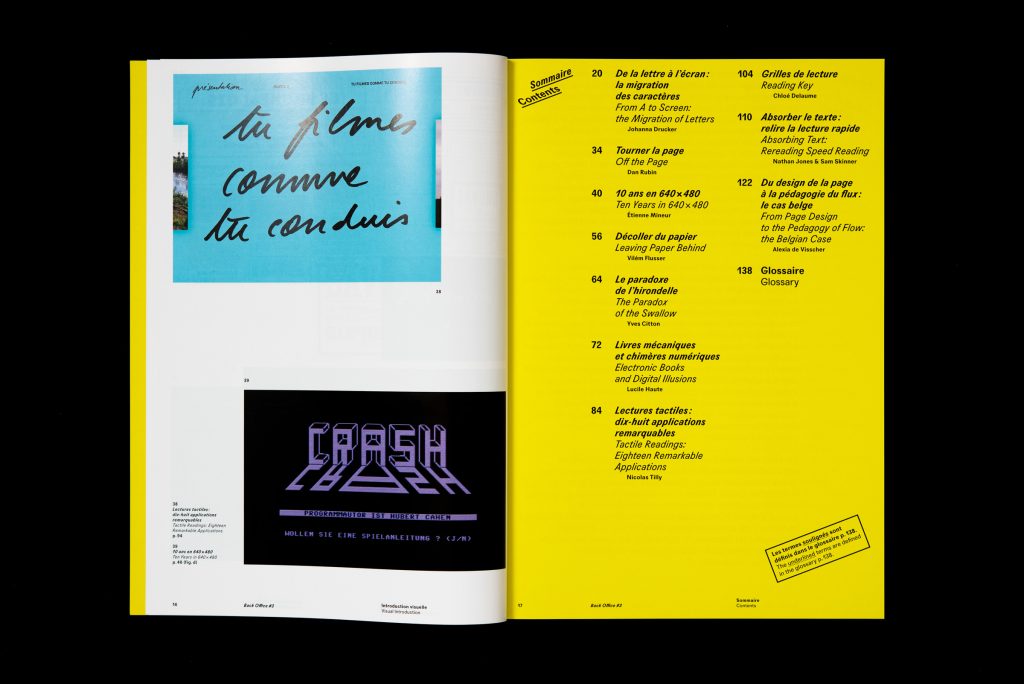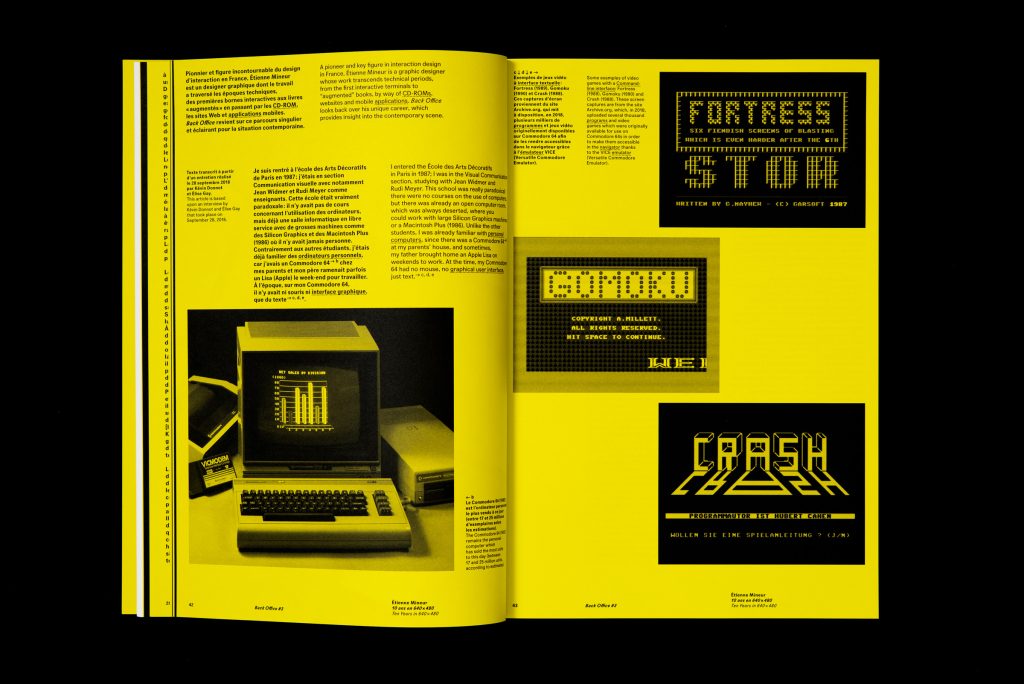BACK OFFICE N°3
GRAPHIC DESIGN AND DIGITAL PRACTICES
B42-112
publication September 2019
language English, French
designer E + K – Élise Gay & Kévin Donnot
size 195 x 280mm
pages 144 p.
ISBN 9782490077120
themes graphic design, typography
Co-published with Fork Éditions
Published with the support of Cnap – Centre national des arts plastiques.
Follow Back Office on Twitter
This third issue of Back Office #3 is devoted to various experiences of reading on screens. Over the course of the last decades, this change has introduced deep shifts whose effects are still being assessed. Following the possible end of linear writing, predicted by the “communicologist” Vilém Flusser as early as the 1970s, the philosopher Jacques Derrida reflected on the “end of paper” as the primary medium for inscription. The proliferation of screens and the dawn of the internet paved the way for expression forms falling under the category of an enlarged “graphosphere”, presumably still dominated by the norms and figures of paper (ligns, the sheet, the page, paragraphs, margins, etc.). Could the task of the designer be to accompany, as smoothly as possible, this transition from one technical era to the next, or could it be, on the contrary, to postpone the passage from paper to screen?
Back Office is an annual review, encompassing graphic design and digital activities. It explores the creative processes at work in the diverse fields of contemporary media and digital practices. By dealing with themes such as the code/form relation, the challenges of creative tools, and the permeable nature of media, it represents a unique French-speaking think tank, and a worldwide vehicle of visibility for the French-speaking community.
CONTENTS
From A to screen: the Migration of Letters
Johanna Drucker
What is a letter? In this article, one of the very few writings by Johanna Drucker to be available in French, the author examines the history of the alphabet and letter-drawing techniques, from Mesopotamia to the technical layers needed to display Web pages.
Off the Page
Dan Rubin
By its mere presence in our vocabulary, the page has conditioned our entire approach to design, layout, browsing, interactions, communication protocols, width, height, above the fold, advertising, and typography. Similarly to books, the internet has evolved according to our perception of its shape. Understanding history and the meaning of the concept of the page could help the internet evolve.
Ten Years in 640 x 480
Étienne Mineur
Etienne Mineur is a designer, publisher and teacher. His career began in the early 1990s designing cultural CD-ROMs. In 2000, he co-founded Incandescence studio, which specialized in interaction design. In 2009, he launched Volumiques, a publishing company producing interactive games and narrative texts.
Leaving Paper Behind
Vilém Flusser
Alphanumerical and iconic information are in the process of coming detached from all material media (especially paper) to fly towards the electromagnetic field. The consequences of this emergence are still unpredictable. This paper will consider only the conceivable consequences that the electromagnetization of texts will have on the writer’s creativity.
The Paradox of the Swallow
Yves Citton
In order to better understand the significance of the challenges that Villèm Flusser explored in his 1987 article, “XXX”, over 30 years later Back Office asked the researcher Yves Citton (a Literature & Media Professor at Paris 8 Vincennes-Saint Denis University) to analyze the electronic mutations of communication media.
Electronic Books and Digital Illusions
Lucile Haute
It is very likely that what is commonly referred to – often without being defined – as an “electronic book” is no longer a book but a hypermedia. What happens to the sensory experience of reading when it is transferred to digital or unconventional media? What disappears and what is created during the translation from one sensory mode to another, from paper to screen, from screen to paper?
Tactile Readings: Eighteen Remarkable Applications
Nicolas Tilly
Nicolas Tilly presents a selection of applications which goes back over a decade of reading on tactile screens.
Reading Keys
Chloé Delaume
My name is Adelaïde Blanchard. I am 37. I am a Lacanian by training, but I am what is commonly referred to as a bibliotherapist. I treat people with books – or with reading at any rate. I prescribe reading. Soothing passages from publications, reassuring pages from novels. Tranquilizing stanza, energizing verse. Aesthetic experience and neuronal circuits.
Absorbing Text: Rereading Speed Reading
Nathan Jones, Sam Skinner
Speed reading applications single out individual words from a text’s body and display them sequentially, most often underlining the middle letter. This article examines how this new temporal textual form could usher in a revival of the technical and material basics of reading, and how it could offer alternative ways to reflect on our relationship to texts.
From Page Design to the Pedagogy of Flow: the Belgian Case
Alexia de Vischer
Teaching design on screens started when the first graphic user interfaces appeared. While a handful of designers used them as research spaces, most of them invested the field of digitally assisted design. The internet’s open and standardized technologies partly allowed these two worlds to meet.














